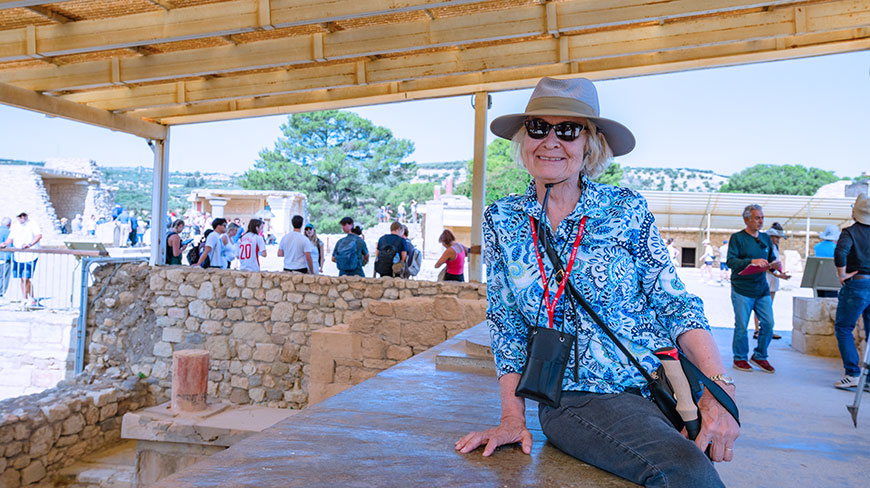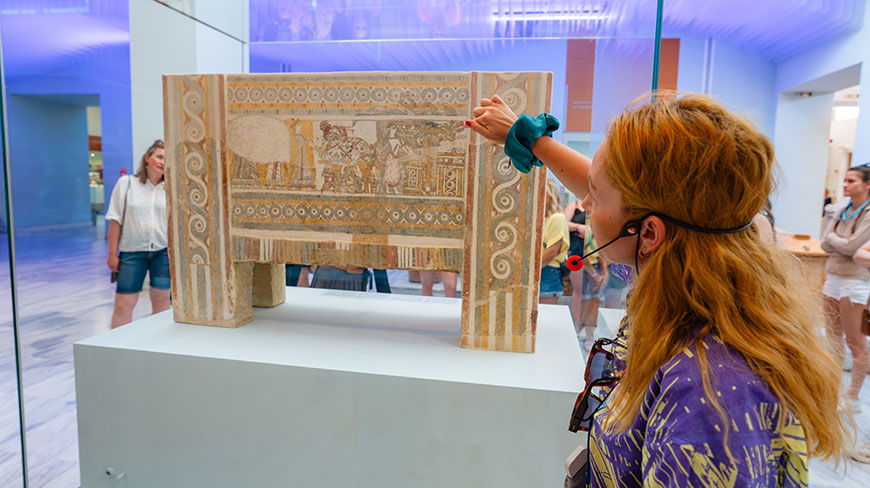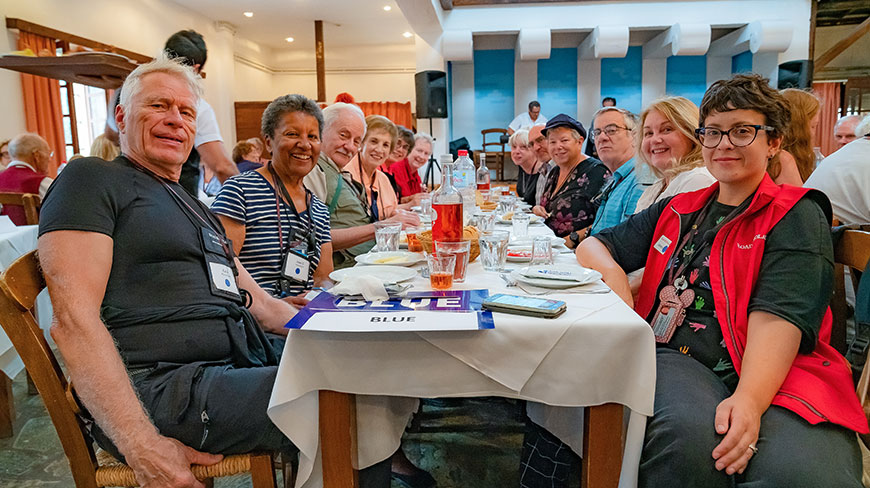Greece
Winter in Greece: The Magical Island of Crete
Program No. 22935RJ
From its arid east to the lush forests of the west, Crete beckons to be explored. Experience this ancient island like a local during the quieter winter months when the climate is mild.
Itinerary
While we make every effort to ensure the accuracy of our published materials, programs are typically advertised more than a year prior to their start date.
Read More.
While we make every effort to ensure the accuracy of our published materials, programs are typically advertised more than a year prior to their start date. As a result, some program activities, schedules, accommodations, personnel, and other logistics occasionally change due to local conditions or circumstances. Should a major change occur, we will make every effort to alert you. For less significant changes, we will update you during orientation. Thank you for your understanding.
Duration
9 days
8 nights
What's Included
15 meals (
7B, 4L, 4D
)
11 expert-led field trips
2 flights during the program
1 hands-on experience
1 performance
An experienced Group Leader
7 nights of accommodations
Taxes and customary gratuity
Road Scholar Assurance Plan
Day
1
In Transit to Program
Location:
In Flight
Day
2
Arrive Athens, Check-in, Orientation, Welcome Dinner
Location:
Athens
Meals:
D
Stay:
Hera Hotel
Activity Note
Hotel check-in from 2:00 p.m. Remember to bring your nametag (sent previously).
Afternoon:
Orientation: 6:00 p.m. The Group Leader will greet everyone and lead introductions. We will review the up-to-date program schedule, discuss roles and responsibilities, logistics, safety guidelines, emergency procedures, and answer questions. Our experienced and knowledgeable Group Leader will also serve as our Study Leader, presenting lectures and conducting field trips. Program-related travel and transfers will be via private bus unless noted otherwise. Periods in the schedule designated as “Free time” and “At leisure” offer opportunities to do what you like and make your experience even more meaningful and memorable according to your personal preferences. The Group Leader will be happy to offer suggestions. Program activities, schedules, personnel, and indicated distances or times may change due to local circumstances/current conditions. In the event of changes, we will alert you as quickly as possible. Thank you for your understanding.
Dinner:
In the hotel restaurant.
Evening:
At leisure.
Day
3
Athens, Flight to Heraklion
Location:
Heraklion
Meals:
B,D
Stay:
Aquila Atlantis Hotel
Activity Note
Getting on/off a bus; driving up to 23 miles, up to 1 hour riding time. Getting on/off an airplane; flight from Athens to Heraklion is approximately 1 hour. Today’s activities will include up to 1 hour of walking.
Breakfast:
In the hotel dining room.
Morning:
Morning Checking out of the hotel, we’ll enjoy a scenic drive through the city of Athens. Our Group Leader will provide commentary, pointing out the iconic landmarks of the city as well as providing some historical and cultural context. After our panoramic drive, we will make our way to the Athens International Airport.
Lunch:
On your own at the Athens Airport.
Afternoon:
We will board a domestic flight towards Heraklion, Crete. Upon arrival, we will transfer via bus to our new hotel and check in. Reconvening right before dinner, we’ll enjoy a short orientation walk through Heraklion during which our Group Leader will point out some local landmarks and give us insight into the island of Crete.
Dinner:
In the hotel dining room.
Evening:
At leisure.
Day
4
Knossos, Heraklion Historical Center
Location:
Heraklion
Meals:
B,L
Stay:
Aquila Atlantis Hotel
Activity Note
Getting on/off a bus. Today’s activities will include walking up to 2 hours on uneven terrain with stairs.
Breakfast:
In the hotel dining room.
Morning:
Morning Heading out by bus, we will begin our day at the Knossos Palace, once the ceremonial and political center of the Minoan civilization but abandoned in the Late Bronze Age (1,380 – 1,100 BCE) for unknown reasons. The builders of this palace achieved an extraordinarily high level of architectural sophistication, and its complex design has made many believe this to be the legendary home of King Minos and the site of the famed labyrinth in which he placed his son, the Minotaur. Returning to Heraklion, we will drive along the Venetian Harbor, the Arsenals as well as the impressive Venetian city walls, considered as of the most important monuments of this type in the entire Mediterranean basin. We will also view the Martinengo Bastion where Crete’s most acclaimed 20th-century writer Nikos Kazantzakis is buried.
Lunch:
At a local restaurant.
Afternoon:
We will head out on a walk through the historical center of Heraklion. Led by our Group Leader, we will explore the old herb market, the Morozini fountain, the Loggia, the Church of Saint Titus and the Church of Saint Mark. Those who wish to extend their walk further may visit the old Venetian Harbor, which includes the impressive fortress of Koules that once protected the entrance to the city.
Dinner:
On your own.
Evening:
At leisure.
Day
5
Rethymnon, Chania
Location:
Heraklion
Meals:
B,L
Stay:
Aquila Atlantis Hotel
Activity Note
Getting on/off a bus; driving up to 170 miles, approximately 4 hours total riding time. Today’s activities will include walking up to 2 hours on even terrain with some stairs.
Breakfast:
In the hotel dining room.
Morning:
We will board the bus and drive along the northwest coast of Crete towards Chania, the second largest city on the island. On our way, we will make a short stop in the city of Rethymnon, one of the few preserved Renaissance cities in all of Greece. Here we will see the beautiful architecture of the area, which bears a strong Venetian and Ottoman influence. br> Then, we’ll continue our drive to the city of Chania. Chania was built atop the ruins of ancient Kydonia, a city-state founded, according to tradition, by the mythical King Minos. Due to its strategic positioning in the Aegean, Chania, experienced throughout its history many invaders. Thus the rich architectural, culinary and cultural legacy which is obvious in every corner of this charming town of western Crete. Upon arrival we’ll start our walk through the old town exploring some of its different historical quarters such as Splanzia known for its attractive alleys, its airy squares, its extraordinary churches and other historical buildings.
Lunch:
At a local restaurant.
Afternoon:
We will continue our exploration of Chania walking along the impressive Byzantine wall of the city, cross the quarter of the traditional knife craftsmen and reach the old harbor, the most recognizable part of the city, where the prevailing Lighthouse. The Lighthouse of Chania’s old harbor, one of the oldest lighthouses in the world, was originally built by the Venetians in the late 16th century and rebuilt by the Egyptians in the early 19th century. We’ll then continue to Etz Hayyim synagogue home to the only surviving mikveh, or ceremonial bath, in Greece. It was converted in the 17th century from a 15th-century church. After many years of damage, it was restored with assistance from the World Monuments Fund and rededicated in 1999. We will learn the fascinating saga of Crete’s Romaniote Jews, a distinctive group who are neither Sephardim nor Ashkenaz, with their own language and religious traditions. We’ll return to Heraklion after our field trip.
Dinner:
On your own.
Evening:
At leisure.
Day
6
Lasithi, Women of Kritsa, Agios Nikolaos
Location:
Heraklion
Meals:
B,L
Stay:
Aquila Atlantis Hotel
Activity Note
Getting on/off a bus; driving up to 120 miles, approximately 2 hours total riding time. Today’s activities will include walking up to 2 hours on hilly terrain, with cobblestones and some stairs.
Breakfast:
In the hotel dining room.
Morning:
We’ll board our bus and drive eastward through Lasithi province, the wildest area of Crete, with the richest biodiversity and least trampled ranges. This is also one of the most authentically “Cretan” areas of the island, little affected by mass tourism. The picturesque, whitewashed village of Kritsa is nestled in the Dikti Mountains. Centuries ago, it was the largest and most prosperous village in Crete, but has been razed and restored from conquest to conquest numerous times. Today, it is notable for traditional arts and crafts as well as the vestiges from the past such as the ancient Byzantine church of Panagia Kera, originally constructed in the 12th century. We will see the church’s colorful Byzantine frescoes and then continue to the village to meet some of the women of Kritsa who have established a cooperative to produce and sell local specialties. We will join them in making a local dish and enjoying it for lunch.
Lunch:
At the women’s cooperative, we’ll have a light country lunch and savor our own creations.
Afternoon:
Next, we will drive by Agios Nikolaos, the fourth-largest town in Crete but with a small-town feel. Our scenic drive takes us along the majestic Mirambello Bay to reach the coastal village of Elounda. From here we may view the Spinalonga island, a former lepers’ colony across the bay from Elounda which has become very popular after the success of “The Island” by Victoria Hislop. Today the island is characterized by its imposing Venetian fortress. We will stop at Elounda for a photo stop. After our field trip, we’ll return to Heraklion.
Dinner:
On your own.
Evening:
At leisure.
Day
7
Mountain Village, Lunch with Locals
Location:
Heraklion
Meals:
B,L,D
Stay:
Aquila Atlantis Hotel
Activity Note
Getting on/off a bus; driving up to 70 miles, less than 2 hours riding time each way. Today’s activities will include walking up to 1.5 hours on uneven terrain with some steps.
Breakfast:
In the hotel dining room.
Morning:
For our next field trip, we will drive to Central Crete, the untamed heart of the island. This area has an uninterrupted human presence that has lived in harmony with nature since the Neolithic Age and has left a rich archaeological heritage in the fertile plains and the nearby mountainous regions. These areas are of high ecological value where sheep and goat farming provides the inhabitants with income for generations. As we explore this part of Crete, we’ll cross the fertile plains where millions of olive trees grow and we’ll talk about the island’s olive oil history. We’ll view the stunning untouched mountains, see local people whose farming roots date back to the Minoan period and beyond and we’ll experience their local crafts. We’ll also have the opportunity to visit one of the historic monasteries of Crete while driving towards one of the oldest and most prestigious wineries of the island where after years of research they brough back the cultivation of ancient and rare grape varieties. At the winery, we’ll be welcomed with a local mountain tea and then we’ll learn all about the viticulture and the production of wine in Crete!
Lunch:
At an atmospheric lodge, we’ll enjoy delicious local delicacies, lovingly prepared by the women of the nearby village who use fresh, local ingredients, nurtured by Mother Earth for centuries in this unspoiled area. Naturally, wine tasting will follow our meal while enjoying music played on the Cretan lyra. This enigmatic, truly unique instrument has survived for approximately 600 years with little alteration to its form.
Afternoon:
We will return to Heraklion, enjoying another beautiful panoramic drive that will allow us to view one of the sacred mountains of the ancient Minoans. The remainder of the afternoon is free.
Dinner:
At a prize-awarded local restaurant, we’ll have a Cretan-style meal where we’ll taste some very traditional local dishes with a glass of wine and a glass of herb-flavored raki.
Evening:
At leisure. Prepare for check-out, transfer, and our flight to Athens tomorrow.
Day
8
Heraklion Archeological Museum, Flight to Athens
Location:
Athens
Meals:
B,D
Stay:
Hera Hotel
Activity Note
Today’s activities will include up to 1 hour of walking, with long periods of standing at the Heraklion Archaeological Museum. Getting on/off a bus. Getting on/off an airplane; flight from Heraklion to Athens is approximately 1 hour.
Breakfast:
In the hotel dining room.
Morning:
Morning We will set out on foot with our Group Leader for an in-depth visit of the Heraklion Archaeological Museum. This museum houses the largest collection of Minoan art in the world and is considered one of the greatest museums in all of Greece. In its rooms and through the extraordinary exhibits, visitors may travel through the 5,500 years of Cretan history. After our visit, we’ll have some time to explore the museum independently.
Lunch:
On your own.
Afternoon:
We will check out and meet at the hotel lobby for our bus transfer to the Heraklion Airport where we will board a domestic flight to Athens. Upon arrival, we’ll transfer to the Athens hotel and check in.
Dinner:
In the hotel dining room. Share favorite experiences and enjoy camaraderie with new Road Scholar friends during our farewell dinner.
Evening:
At leisure. Prepare for check-out and departure in the morning.
Day
9
Program Concludes, In Transit From Program
Location:
In Flight
Meals:
B
Activity Note
Hotel check-out by 12:00 Noon. See your program’s “Getting There” information regarding transfers.
Breakfast:
In the hotel dining room. This concludes our program.
Morning:
If you are returning home, safe travels. If you are staying on independently, have a wonderful time. If you are transferring to another Road Scholar program, detailed instructions are included in your Information Packet for that program. We hope you enjoy Road Scholar learning adventures and look forward to having you on rewarding programs in the future. Don't forget to like our Facebook page or follow us on Instagram. Best wishes for all your journeys!
Please select a day to update the map
Map details are not available for this location.









